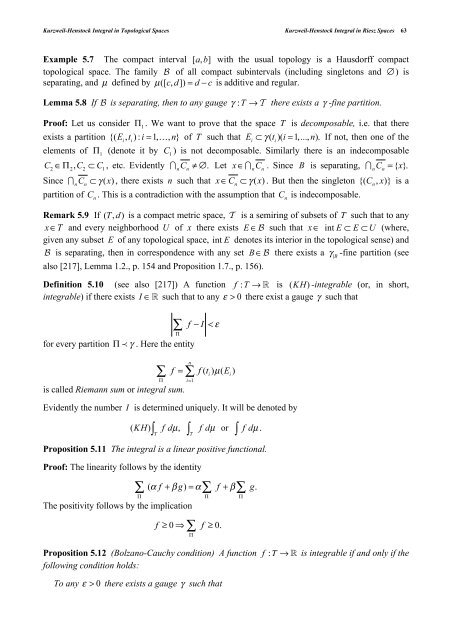Kurzweil-Henstock Integral in Riesz spaces - Bentham Science
Kurzweil-Henstock Integral in Riesz spaces - Bentham Science
Kurzweil-Henstock Integral in Riesz spaces - Bentham Science
You also want an ePaper? Increase the reach of your titles
YUMPU automatically turns print PDFs into web optimized ePapers that Google loves.
<strong>Kurzweil</strong>-<strong>Henstock</strong> <strong>Integral</strong> <strong>in</strong> Topological Spaces <strong>Kurzweil</strong>-<strong>Henstock</strong> <strong>Integral</strong> <strong>in</strong> <strong>Riesz</strong> Spaces 63<br />
Example 5.7 The compact <strong>in</strong>terval with the usual topology is a Hausdorff compact<br />
topological space. The family of all compact sub<strong>in</strong>tervals (<strong>in</strong>clud<strong>in</strong>g s<strong>in</strong>gletons and ) is<br />
separat<strong>in</strong>g, and def<strong>in</strong>ed by is additive and regular.<br />
Lemma 5.8 If is separat<strong>in</strong>g, then to any gauge there exists a -f<strong>in</strong>e partition.<br />
Proof: Let us consider . We want to prove that the space is decomposable, i.e. that there<br />
exists a partition of such that If not, then one of the<br />
elements of (denote it by ) is not decomposable. Similarly there is an <strong>in</strong>decomposable<br />
, etc. Evidently Let . S<strong>in</strong>ce is separat<strong>in</strong>g,<br />
S<strong>in</strong>ce , there exists such that . But then the s<strong>in</strong>gleton is a<br />
partition of . This is a contradiction with the assumption that is <strong>in</strong>decomposable. <br />
Remark 5.9 If is a compact metric space, is a semir<strong>in</strong>g of subsets of such that to any<br />
and every neighborhood of there exists such that (where,<br />
given any subset of any topological space, denotes its <strong>in</strong>terior <strong>in</strong> the topological sense) and<br />
is separat<strong>in</strong>g, then <strong>in</strong> correspondence with any set<br />
also [217], Lemma 1.2., p. 154 and Proposition 1.7., p. 156).<br />
there exists a -f<strong>in</strong>e partition (see<br />
Def<strong>in</strong>ition 5.10 (see also [217]) A function is -<strong>in</strong>tegrable (or, <strong>in</strong> short,<br />
<strong>in</strong>tegrable) if there exists such that to any there exist a gauge such that<br />
for every partition . Here the entity<br />
is called Riemann sum or <strong>in</strong>tegral sum.<br />
Evidently the number is determ<strong>in</strong>ed uniquely. It will be denoted by<br />
Proposition 5.11 The <strong>in</strong>tegral is a l<strong>in</strong>ear positive functional.<br />
Proof: The l<strong>in</strong>earity follows by the identity<br />
The positivity follows by the implication<br />
Proposition 5.12 (Bolzano-Cauchy condition) A function is <strong>in</strong>tegrable if and only if the<br />
follow<strong>in</strong>g condition holds:<br />
<br />
To any there exists a gauge such that

















